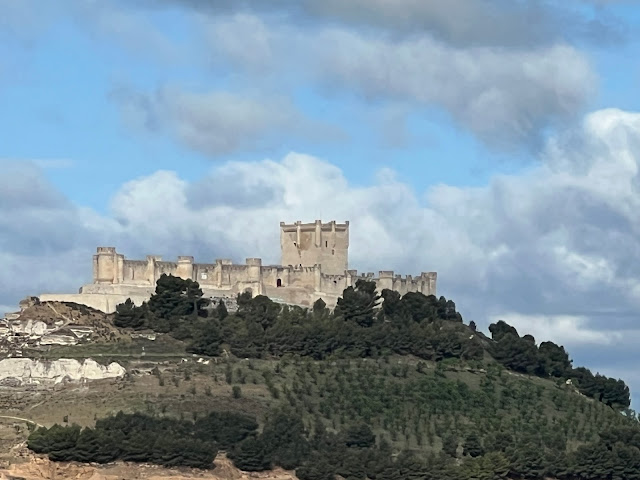Ribera del Duero's Convento Oreja has been described as where a dream is born. Last May, I joined WineMine friends from Portugal for SweetEasy wine explorations in Ribera del Duero. Our visit to Convento Oreja was all about living the dream in Ribera del Duero wine country!
That day began at Pago de Carraovejas for a wine and food pairing, followed by lunch at Mélida, a boutique winery, and concluded with a wine tasting at Convento Oreja. Convento Oreja is located in the historical center of the Ribera del Duero. It was founded by a group of wine enthusiasts who had been thinking about it for a very long time. Their goal for achieving their dream was - to enjoy our friendship by tasting a glass of our own wine, a glass which gathered our own style, our passion, our work and the work of the nature in the lands of the Ribera del Duero.
They chose Convento Oreja for the name of the winery and the wine. The owners decided on this to celebrate of one of their icons, a very old Cistercian convent (Convento de Santa María de Oreja) in the Langayo township. The convent has been abandoned for more than four centuries. The convent got its name from that fact that it was located in a valley with a shape of an ear (oreja).
When we visited Convento Oreja we discovered wonderful wines and amazing hospitality.
Convento Oreja wines are varied expressions of Tinta del País grapes, a variety of Tempranillo. We tasted Convento Oreja Roble, Convento Oreja Crianza, and Convento Oreja Memoria Reserva wines.
1. Convento Oreja Roble, DO Ribera Del Duero 2021
2. Convento Oreja Crianza, DO Ribera Del Duero 2019
Convento Oreja Crianza, DO Ribera Del Duero 2019 © Spaswinefood
3. Convento Oreja Memoria Reserva, DO Ribera Del Duero 2018
Convento Oreja Memoria Reserva, DO Ribera Del Duero 2018 © Spaswinefood
Tasting Convento Oreja wines was a perfect way to end the day's wine travels.
Tasting a Convento Oreja Crianza, DO Ribera Del Duero 2004 was a perfect ending to the tasing.
Ribera del Duero Wine Country
Indeed, I had come to experience today's Ribera del Duero first hand. Over three days, we visited a variety of wineries, ranging from boutique to large scale producers. In addition, our foodie adventures included enjoying traditional to modern style cuisine. Convento Oreja was a special part of our vine-filled explorations.
Ribera del Duero DO is located in northern Spain's Castilla y León region. There on the northern plateau of the Iberian Peninsula, along the sides of the Duero River, the wine region occupies the southern plains of Burgos province, extends west to Valladolid, and into parts of Segovia and Doris provinces. The appellation received DO status in 1982. In 2008, it was approved for Denominación de Origen Calificada (DOCa) status however, it never pursued this classification, so it remains a DO appellation. It is one of Spain's best red wine regions. It is known for its Tempranillo (Tinto Fino), which is often blended with Cabernet Sauvignon, Merlot and Malbec, up to 25 %. The appellation is almost exclusively red and rosado (rosé) wines. To be recognized as DO, its red wines must contain a minimum of 75 % Tempranillo. No more than 5 % Garnacha or Albillo, in total, may be added. Its Rosado wines must have a minimum of 50 % of the authorized red varieties. The white wine produced, mostly for local consumption, is Albillo. DO regulations require at least 75 % of Albillo grapes be used.
Spring time was great timing to checkout the wines, the cuisine and admire the landscape, dotted with poppies. During my springtime visit many times we passed the historic castle on the hill overlooking Peñfiel.
Convento Oreja, Ribero del Duero is where the wine is oh so great and a dream is born I invite you to join me in my wine travels in Spain and elsewhere at Wine Travels with Dr. Sharon, and at Spaswinefood on Twitter and Facebook. I am so looking forward to more vine-filled explorations in Spain.
The following styles of wines include:
Joven or barrica. These wines cannot age for more than 12 months.
Crianza. The wines must stay at least 12 months in oak barrel and cannot be released before 24 months.
Reserva. The wines undergo 36 months of aging and at least 12 months in oak barrels.
Gran Reserva. The wines undergo 60 months aging, at least 24 months.
The names used are similar to those of other Denominaciones in Spain however, the specifics may vary.






























No comments:
Post a Comment